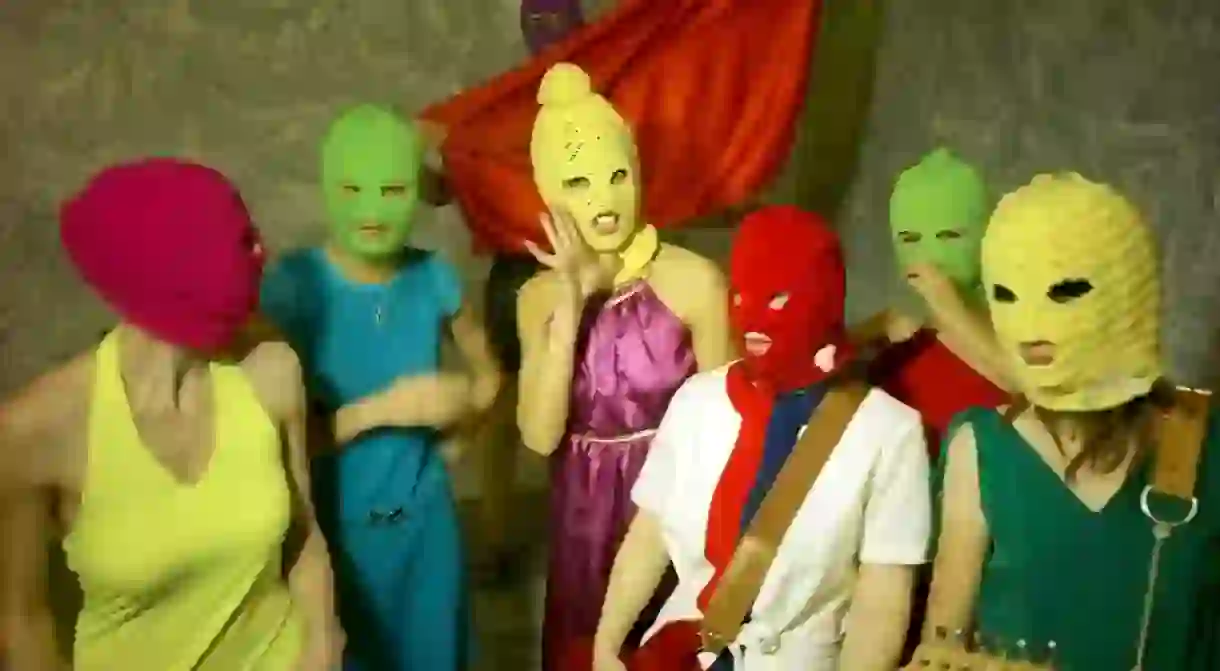7 Russian Performance Artists Who Have More Fans than Hollywood Actors

It’s not just rock stars and Instagram celebrities who amass large fan bases. Performance artists also often accrue a cult following as their art projects are regularly absurd, comical, confronting or completely shocking. World Cup 2018 host nation Russia, has several performance artists whose use of endurance and shock tactics, when creating highly conceptual and politically driven work, has seen them gain notoriety in Russia and beyond. Here are seven Russian performance artists who are almost household names.
Alexander Brener
One of the earlier commentators on the Russian Federation, Brener is most well known for his 1995 performance, Yeltsin, come out, where he dressed up as a boxer, preparing for a fight and taunted Yeltsin to come out from the Kremlin. He has also attempted to have sex with his wife on the steps of one of the monuments to Pushkin, pretended to defecate on a Van Gogh painting, stapled the back of his neck during an exhibition at the Central House of Artists and masturbated on top of the Moscow swimming pool’s diving tower. He is considered to be one of the instigators of Moscow Actionism, a strand of highly political and confronting performance art that came out of the Russian Federation in the 1990s.
Glupie Lyudi
While they may not be well known now, the performance collective Glupie Lyvdi, or ‘Stupid People’, did have their moment in the spotlight when they were active in the early to mid-2000s. Driven by the ridiculous and the nonsensical, stand-out performances include Guidebook, where collective members took to the streets of Moscow, aided with a map of Bali and asking the general public for help and Guess Who, where they covered policemen’s eyes with their hands while pretending to be old friends. Collectively, they also did the gross job of picking off chewing gum from the metro floor.
Pyotr Pavlensky
Perhaps a continuation on from the Moscow Actionism of the 90s, Pavlensky’s performances are extreme, outrageous and somewhat concise. His ardent opposition to the state and unwavering criticism of government institutions has seen him tow a fine line between extremist, artist and mutineer in his unapologetic and unwavering acts of protest. Carving a name for himself during the Pussy Riot trial of 2012, where he sewed his lips together, he went on to nail his testicles to the cobbles of Red Square and cut some of his ear off with a particularly long and menacing knife. He has now moved on from mutualising his own body to damaging public property. In 2015 he set fire to the entrance to the offices of the FSB security service (the successor to the KGB), and in 2017 he set fire to a Bank of France building in Paris.

Voina
Founded in 2o05, Viona, meaning war in Russian, is an anarchistic political performance art collective who also like to make a bold statement. While the core members ebb and flow, some consider the group to be Pussy Riot’s precursor as members Maria Alyokhina and Nadezhda Tolokonnikova went on to be part of the now infamous Riot Grrrls of Russia. Never afraid of controversy, confrontation or some sideways thinking, performances have included throwing cats at McDonalds workers, staging a fake road accident and a hanging, as well as group sex in protest at Dmitry Medvedev’s appointment as Prime Minister. Despite their controversy, the Russian Ministry of Culture awarded them the prize for art innovation in 2011, for their giant penis painted on St. Petersburg’s Liteyny drawbridge opposite the FSB headquarters. When raised for the night the security service building had a prime phallus viewing position.

Pussy Riot
One of the most famous performance art collectives, having firmly established themselves within world pop culture. Members Alyokhina and Tolokonnikova even appeared in a House of Cards episode. Primarily an LGBTQ+ activist group made up of young woman who wear brightly coloured balaclavas, they entered global consciousness when they stormed the Cathedral of Christ Our Saviour in Red Square and performed a brief punk song, Riot in Russia – Putin’s wet himself. For this song members were persecuted and imprisoned for several years.

Artyom Loskutov
Creator of Monstration, Artyom Loskutov from Novosibirsk employs silliness and humour to undermine political agenda. Monstration has been subverting annual Victory Day parades, the parade celebrating Soviet Union’s victory over Nazi Germany in WWII, since 2004. Somewhat of an anti-parade that mocks the nationalistic celebration, people dress up in costumes and brandish placards with nonsense slogans on them, such as Get a cat, Make love not work, So what?, We are not vegetables and Yesterday was Tuesday, but today is Tuesday as well. Loskutov was arrested in 2009, which only publicised his cause and now Monstration pulls crowds as large as 4000 people in Novosobirsk and up to several hundred in other Russian cities. In 2010, Loskutov was awarded the Innovation prize, Russia’s equivalent of the Turner Prize.

Teatr Doc
More conventional theatre than performance art, Teatr Doc have still caused controversy with their style of hard-hitting theatre that contains razor-sharp commentary on contemporary Russian culture. Creating works of documentary theatre, (theatre cemented in real life that uses evidence such as verbatim scripts, archival images and footage to address the topic at hand), their tenancy in a basement theatre in Moscow was abruptly and inexplicably cut short in 2014. This fuelled theories that the eviction was an attempt at censorship due to their highly controversial repertoire that includes a play about the imagined trial of the prison and medical staff involved in the final days before the death of solicitor Sergei Magnitsky while in police custody.













